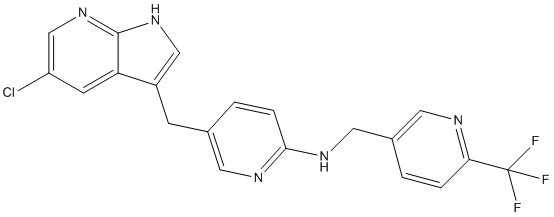All AbMole products are for research use only, cannot be used for human consumption.

Pexidartinib (PLX3397) is an oral, potent mutil-targeted receptor tyrosine kinase inhibitor of CSF-1R, Kit, and Flt3 with IC50 of 20 nM, 10 nM and 160 nM, respectively. In M-NFS-60, Bac1.2F5 and M-07e cells, Pexidartinib inhibits the CSF1-dependent proliferation with IC50 of 0.44 μM, 0.22 μMand 0.1 μM, respectively.
In C57 mice bearing GL261 tumors, Pexidartinib (p.o.) inhibits glioblastoma invasion. In mice bearing B16F10 melanomas, Pexidartinib (45 mg/kg, p.o.) enhances CD8-mediated immunotherapy of melanoma.

PNAS Nexus. 2024 Aug 22.
CYP7B1 deficiency impairs myeloid cell activation in autoimmune disease of the central nervous system
Pexidartinib purchased from AbMole

Cancer Lett. 2022 Feb 28;527:174-190.
Hippo/YAP Signaling Choreographs The Tumor Immune Microenvironment to Promote Triple Negative Breast Cancer Progression Via TAZ/IL-34 Axis
Pexidartinib purchased from AbMole
| Cell Experiment | |
|---|---|
| Cell lines | GIST, MPNST, and ST8814 cells |
| Preparation method | Cell viability assays. Briefly, 2,000 cells were plated in 96-well plates in RPMI media with 10% FBS and then treated with the indicated drugs the next day. Media were replaced with 100 μL of media with 10% serum and 10% CCK-8 (AbMole) solution. After 1 hour, the optical density was read at 450 nm using a Spectra Max 340 PC to determine viability. Background values from negative control wells without cells were subtracted for final sample quantification. Data were plotted as % cell viability compared with dimethyl sulfoxide (DMSO; no drug) control. |
| Concentrations | 0~1μM |
| Incubation time | 144h |
| Animal Experiment | |
|---|---|
| Animal models | Ten-week-old mice fed a chow or high-fat diet for 10 weeks |
| Formulation | dissolved in 5% DMSO and 25% PEG300 in ddH2O |
| Dosages | 50 mg/kg every second day for 3 weeks |
| Administration | oral gavage |
| Molecular Weight | 417.81 |
| Formula | C20H15ClF3N5 |
| CAS Number | 1029044-16-3 |
| Solubility (25°C) | DMSO 15 mg/mL |
| Storage |
Powder -20°C 3 years ; 4°C 2 years In solvent -80°C 6 months ; -20°C 1 month |
| Related c-Kit Products |
|---|
| Labuxtinib
Labuxtinib is c-kit tyrosine kinase inhibitor. |
| Elenestinib phosphate
Elenestinib phosphate (BLU-263 phosphate) is a potent and orally active tyrosine kinase inhibitor. Elenestinib phosphate has the potential for the research of systemic mastocytosis (SM). |
| Elenestinib
Elenestinib (BLU-263) is a potent and orally active tyrosine kinase inhibitor. Elenestinib has the potential for the research of systemic mastocytosis (SM). |
| Bezuclastinib
Bezuclastinib (CGT9486; PLX 9486) is a potent inhibitor of c-kit and c-kit D816V (0.0001 < IC50 < 1 μM). Bezuclastinib is a tyrosine kinase inhibitor. |
| Amuvatinib hydrochloride
Amuvatinib hydrochloride (MP470 hydrochloride) is an orally bioavailable multi-targeted tyrosine kinase inhibitor with potent activity against mutant c-Kit, PDGFRα, Flt3, c-Met and c-Ret. Amuvatinib hydrochloride (MP470 hydrochloride) is also a DNA repair suppressor through suppression of DNA repair protein RAD51, thereby disrupting DNA damage repair. Antineoplastic activity. |
All AbMole products are for research use only, cannot be used for human consumption or veterinary use. We do not provide products or services to individuals. Please comply with the intended use and do not use AbMole products for any other purpose.


Products are for research use only. Not for human use. We do not sell to patients.
© Copyright 2010-2024 AbMole BioScience. All Rights Reserved.
